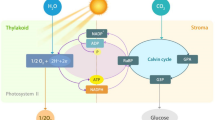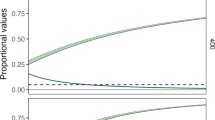Abstract
Atmospheric ammonia (NH3) from various anthropogenic sources has become a serious problem for natural vegetation. Ammonia not only causes changes in plant nitrogen metabolism, but also affects the acid-base balance of plants. Using the pH-sensitive fluorescent dyes pyranine and esculin, cytosolic and vacuolar pH changes were measured in leaves of C3 and C4 plants exposed for brief periods to concentrations of NH3 in air ranging from 1.33 to 8.29 μmol NH3 · mol-1 gas (0.94–5.86 mg · m-3). After a lag phase, uptake of NH3 from air at a rate of 200 nmol NH3 · m - 2 leaf area · s- 1 into leaves of Zea mays L. increased pyranine fluorescence indicating cytosolic alkalinisation. The increase was much larger in the dark than in the light. In illuminated leaves of the C3 plant Pelargonium zonale L. and the C4 plants Z. mays and Amaranthus caudatus L., NH3-dependent cytosolic alkalinisation was particularly pronounced when CO2 was supplied at very low levels (16 or 20 μmol CO2 · mol- 1 gas, containing 210 mmol O2 · mol- 1 gas). An increase in esculin fluorescence, which was smaller than that of pyranine, was indicative of trapping of some of the NH3 in the vacuoles of leaves of Spinacia oleracea L. and Z. mays. Photosynthesis and transpiration remained unchanged during exposure of illuminated leaves to NH3, yielding an influx of 200 nmol NH3 · m-2 leaf area · s-1 for up to 30 min, the longest exposure time used. Both CO2 and O2 influenced the extent of cytosolic alkalinisation. At 500 μmol CO2 · mol-1 gas the cytosolic alkalinisation was suppressed more than at 16 or 20 μmol CO2 · mol-1 gas. The suppressing effect of CO2 on the NH3induced alkalinisation was larger in illuminated leaves of the C4 plants Z. mays and A. caudatus than in leaves of the C3 plant P. zonale. A reduction of the O2 concentration from 210 to 10 mmol O2 · mol -1 gas, which inhibits photorespiration, increased the NH3induced cytosolic alkalinisation in C3 plants. Suppression by CO2 or O2 of the alkaline pH shift caused by the dissolution and protonation of NH3 in queous leaf compartments, and possibly by the production of organic compounds synthesised from atmospheric NH3, indicates that NH3 which enters leaves is rapidly assimilated if photosynthesis or photorespiration provide nitrogen acceptor molecules.
Similar content being viewed by others
References
Beauchamp EG (1983) Nitrogen loss from sewage sludges and manures applied to agricultural lands. In: Freney JR, Simpson JR (eds) Gaseous loss of nitrogen from plant soil systems. M Nijhoff, The Hague, pp 181–195
Bertl A, Felle H, Bentrup FW (1984) Amine transport in Riccia fluitans. Cytopiasmic and vacuolar pH recorded by a pH-sensitive microelectrode. Plant Physiol 76: 75–78
Bobbink R, Heil GW, Raessen MBAG (1992) Atmospheric deposition and canopy exchange processes in the heathland ecosystems. Environ Pollut 75: 29–37
Cowling DW, Lockyer DR (1981) Increased growth of ryegrass exposed to ammonia. Nature 292: 337–338
Denmead OT (1974) Ammonia flux into the atmosphere from a grazed pasture. Science 185: 609–610
Edwards GE, Walker DA (1983) C3, C4: Mechanisms, and cellular and environmental regulation, of photosynthesis. Blackwell Scientific Publications, Oxford
Fangmeier A, Hadwiger-Fangmeier A, Van der Eerden L, Jaeger H-J (1994) Effects of atmospheric ammonia on vegetation — a review. Environ Pollut 86: 43–82
Farquhar GD, Firth PM, Wetselaar R, Weir B (1980) On the gaseous exchange of ammonia between leaves and the environment: determination of the ammonia compensation point. Plant Physiol 66: 710–714
Freney JR, Simpson JR, Denmead OT (1983) Volatilization of ammonia. In: Freney JR, Simpson JR (eds) Gaseous loss of nitrogen from plant soil systems. M Nijhoff, The Hague, pp 1–33
Harel E, Lea PJ, Miflin BJ (1977) The location of enzymes of nitrogen assimilation in maize leaves and their activities during greening. Planta 134: 195–200
Hatch MD (1987) C4 photosynthesis: a unique blend of modified biochemistry, anatomy and ultrastructure. Biochim Biophys Acta 893: 81–106
Husted S, Schjörring JK (1995) Apoplastic pH and ammonium concentration in leaves of Brassica napus L. Plant Physiol 109: 1453–1460
Kurkdjian A, Guern J (1989) Intracellular pH: measurement and importance in cell activity. Annu Rev Plant Physiol Plant Mol Biol 40: 271–303
Lockyer DR, Whitehead DC (1986) The uptake of gaseous ammonia by the leaves of Italian ryegrass. J Exp Bot 37: 919–927
Moore R, Black CC (1979) Nitrogen assimilation pathways in leaf mesophyll and bundle sheath cells of C4 photosynthesis plants formulated from comparative studies with Digitaria sanyuinalis L. Scop. Plant Physiol 64: 309–313
Müller R, Steigner W, Gimmler H, Kaiser WM (1990) Effect of ammonium on dark-CO2 fixation and on cytosolic and vacuolar pH values in Eremosphaera viridis de Bary (Chlorococcales). J Exp Bot 225: 441–448
Netter H (1959) Theoretische Biochemie, physikalisch-chemische Grundlagen der Lebensvorgänge. Springer-Verlag, Berlin
Pfanz H (1994) Apoplastic and symplastic proton concentrations and their significance for metabolism. In: Schulze E-D, Caldwell MM (eds) Ecological studies 100, ecophysiology of photosynthesis. Springer, Berlin, pp 103–122
Raghavendra AS, Yin Z-H, Heber U (1993) Light dependent pH changes in leaves of C4 plants. Comparison of the pH response to carbon dioxide and oxygen with that of C3 plants. Planta 189: 278–287
Raven JA (1986) Biochemical disposal of excess H+ in growing plants? New Phytol 104: 175–206
Raven JA (1988) Acquisition of nitrogen by the shoots of land plants: its occurrence and implications for acid base regulation. New Phytol 109: 1–20
Raven JA (1995) Symplasmic proton fluxes in photosynthesising and developing plant tissues. Biol Rev 70: 189–224
Raven JA, Farquhar GD (1981) Methylammonium transport in Phaseolus vulgaris leaf slices. Plant Physiol 67: 859–863
Raven JA, Farquhar GD (1989) Leaf apoplast pH estimation in Phaseolus vulgaris. In: Dainty J, De Michelis MI, Marré E, Rasi-Caldogno F (eds) Plant membrane transport: the current position. Elsevier, Amsterdam, pp 607–610
Raven JA, Wollenweber B, Handley L (1992) Ammonia and ammonium fluxes between photolithotrophs and the environment in relation to the global nitrogen cycle. New Phytol 121: 5–18
Ritchie RJ (1987) The permeability of ammonia, methylamine and ethylamine in the charophyte Chara corallina (C. australis). J Exp Bot 38: 67–76
Schulze E-D, De Vries W, Hauhs M, Rosén K, Rasmussen L, Tamm CO, Nisson J (1989) Critical loads for nitrogen deposition on forest ecosystems. Water Air Soil Pollut 48: 451–456
Wagner U, Kolbowski J, Oja V, Laisk A, Heber U (1990) pH homeostasis of the chloroplast stroma can protect photosynthesis of leaves during influx of potentially acidic gases. Biochim Biophys Acta 106: 115–120
Whitehead DC, Lockyer DR (1987) The influence of the concentration of gaseous ammonia on its uptake by the leaves of italian ryegrass, with and without an adequate supply of nitrogen to roots. J Exp Bot 38: 818–827
Winter H, Robinson DG, Heldt HW (1994) Subcellular volumes and metabolite concentrations in spinach leaves. Planta 193: 530–535
Wollenweber B, Raven JA (1993) Nitrogen acquisition from atmospheric NH3 by Lolium perenne: utilization of NH3 and implications for acid base balance. Bot Acta 106: 42–51
Yin Z-H, Neimanis S, Wagner U, Heber U (1990a) Light-dependent pH changes in leaves of C3 plants. I. Recording pH changes in various cellular compartments by fluorescent probes. Planta 182: 244–252
Yin Z-H, Neimanis S, Heber U (1990b) Light dependent pH changes in leaves of C3 plants. II. Effect of CO2 and O2 on the cytosolic and the vacuolar pH. Planta 182: 253–261
Yin Z-H, Dietz K-J, Heber U (1990c) Light dependent pH changes in leaves of C3 plants. III. Effect of inhibitors of photosynthesis and of the developmental state of the photosynthetic apparatus on cytosolic and vacuolar pH. Planta 182: 262–269
Yin Z-H, Siebke K, Heber U (1991) Light dependent pH changes in leaves of C3 plants. IV. Action spectra indicate indirect energization of transport into mesophyll vacuoles by cyclic photophosphorylation. Planta 184: 30–34
Yin Z-H, Heber U, Raghavendra AS (1993) Light dependent pH changes in leaves of C4 plants. Comparison of cytosolic alkalization and vacuolar acidification with that of C3 plants. Planta 189: 267–277
Yin Z-H, Hüve K, Heber U (1996) Light dependent proton transport into mesophyll vacuoles of C3 plants as revealed by pH-indicating fluorescent dyes: a reappraisal. Planta 199: 9–17
Author information
Authors and Affiliations
Additional information
This work was supported by the Biotechnology and Biological Sciences Research Council and the Deutsche Forschungsgemein-schaft within the framework of the research of Sonderforschun-gsbreich 251 of the University of Würzburg. We are grateful to Dr. B. Wollenweber (The Royal Veterinary and Agricultural University, Denmark) for discussions.
Rights and permissions
About this article
Cite this article
Yin, ZH., Kaiser, W.M., Heber, U. et al. Acquisition and assimilation of gaseous ammonia as revealed by intracellular pH changes in leaves of higher plants. Planta 200, 380–387 (1996). https://doi.org/10.1007/BF00231393
Received:
Accepted:
Issue Date:
DOI: https://doi.org/10.1007/BF00231393




